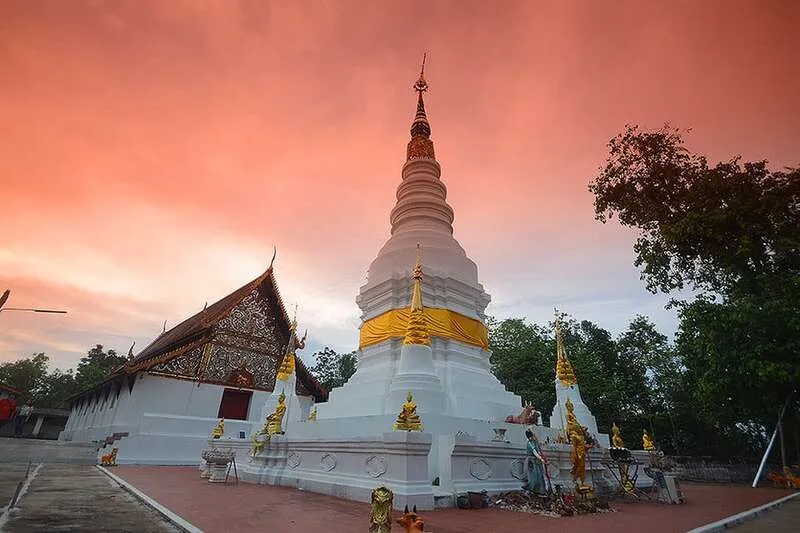Wat Doi Pa Tan

Rating: 3/5 (9 votes)
Lampang attractions
Attractions in Thailand
Operating day: Daily
Operating time: 08.00 - 17.00
Wat Doi Pa Tan is located at No. 33, Moo 8, Lao Makok, Thoen Buri Subdistrict, Thoen District, Lampang Province, postal code 52160. It is a private temple under the Mahanikaya sect, covering an area of 111 rai. The temple was officially established in 1721 (B.E. 2264) and was originally known as Wat Thon Wua Non, or “Temple of the Lying Ox Log.” It was built between 1926–1928 (B.E. 2469–2471) by the revered monk Kruba Srivichai and his disciples. In 1934 (B.E. 2477), it came under the supervision of the Fine Arts Department. The temple’s main festival is held on the 15th day of the waxing moon in the 8th lunar month of the northern Thai calendar, known as Visakha Bucha.
The temple is situated approximately five kilometers from the Thoen District Office. According to legend, in one of his past lives, the Bodhisattva was born as a great ox, born from a red bull and a cow. He wandered into the forest west of the Wang River, which was home to many wild animals. There were three giants who guarded hidden treasures of gems, gold, and silver. The cow lay down to rest in this area, hence the name Mon Wua Non, or “Lying Ox Hill.” A holy monk later came to the area to meditate, and since then, the site has been considered sacred and a place for devout monks and laypeople to practice Dhamma.
The viharn, or assembly hall, is a historic structure in Thoen District. Built in 1926 (B.E. 2469), it measures 12 meters in width and 22 meters in length. The architectural style is a blend of Lanna and Burmese influences, with a roof made from terracotta tiles. It was built by Kruba Srivichai and his followers. Surrounding the viharn are open-sided pavilions measuring 3 meters wide and 40 meters long, still preserved in their original form.
A sacred well is located in the center of the temple grounds. This round concrete well is 14 meters deep and 1.5 meters in diameter. It was excavated in 1935 (B.E. 2478) and is believed to be over 75 years old, showcasing Lanna-style construction. Despite being on a mountain, the well has never run dry. It is believed to be a sacred or miraculous well. Devotees draw water from it and use it in prayer, believing it has healing properties.
The naga stairway is another notable feature, constructed around 1943 (B.E. 2486) during the time of Kruba Srivichai. It is a steep cement staircase about 90 meters long and 2.8 meters wide, with 50 steps. The design follows traditional Lanna style. On major Buddhist holidays, worshippers climb the stairway to pay homage to the sacred relics housed at the temple, seeking blessings for themselves and their families.
The temple’s scripture library, or ho trai, is a half-brick, half-wood structure measuring 4.6 meters wide and 9 meters long. It is approximately 72 years old and built in the Lanna architectural style. It houses palm-leaf manuscripts and the Tripitaka. The ho trai was built in 1940 (B.E. 2481) by Kruba Kham Ho Chaiwong. Kruba Sima Phromchokko later renovated it, replacing the roof tiles and some wooden elements while preserving the original stucco and wood-carved gable. The restoration was completed on December 18, 2005.
Phra That Chao Mon Wua Non is a sacred stupa located on the western side of Thoen District. It is a highly revered religious monument for the people of Thoen and nearby provinces. Legend holds that the Buddha, in a past life, was born as a noble ox named Usuphara. He lived on this hill with his followers until his death. After attaining enlightenment, the Buddha returned to this mountain with Ananda and other disciples to enshrine strands of his hair. At that time, the area was uninhabited. The Buddha handed three strands of hair to Ananda, who stored them in relic containers. People, celestial beings, and the three guardian giants saw the relics emitting different colored lights: red, dull, green, and yellow. This led to disagreements among the people, who often argued about what they saw. The Buddha predicted that future inhabitants of the area would have a tendency to argue and would need monks to mediate and resolve disputes.
To this day, the people of Thoen pay deep respect to Phra That Chao Mon Wua Non as a sacred symbol of their community. An annual relic worship ceremony is held on the full moon of the eighth lunar month.
Comment
| Keyword (Advance) |
 Facebook Fanpage
Facebook Fanpage

 Category:
Category:  Group:
Group:  Art, Culture and Heritage
Art, Culture and Heritage Historical Sites and Monuments(
Historical Sites and Monuments( Landmarks and Memorials(
Landmarks and Memorials( Art, Craft Centres, Tradition(
Art, Craft Centres, Tradition( Museums(
Museums( Historical Houses and The Ancient City(
Historical Houses and The Ancient City( University
University Other religious and spiritural sites(
Other religious and spiritural sites( Research and Development
Research and Development Royal Project(
Royal Project( Suburban Living
Suburban Living Village, Community(
Village, Community( Local Market(
Local Market( Nature and Wildlife
Nature and Wildlife National Parks and Marine Reserves(
National Parks and Marine Reserves( Mountain (Doi)(
Mountain (Doi)( Dam, Reservoir, Lake(
Dam, Reservoir, Lake( Waterfalls(
Waterfalls( Hot Springs(
Hot Springs( Caves(
Caves( Flower Field(
Flower Field( River, Canal(
River, Canal( Bays and Beaches(
Bays and Beaches( Other natural attractions(
Other natural attractions( Entertainment and Agricultural
Entertainment and Agricultural Animal camps and shows(
Animal camps and shows( Farm, Parks, Gardens and Ecotourism(
Farm, Parks, Gardens and Ecotourism( Outdoor and Adventure Activities(
Outdoor and Adventure Activities( Shopping
Shopping Shopping and Night Market(
Shopping and Night Market( Spas and Wellness
Spas and Wellness Spas and Wellness(
Spas and Wellness(